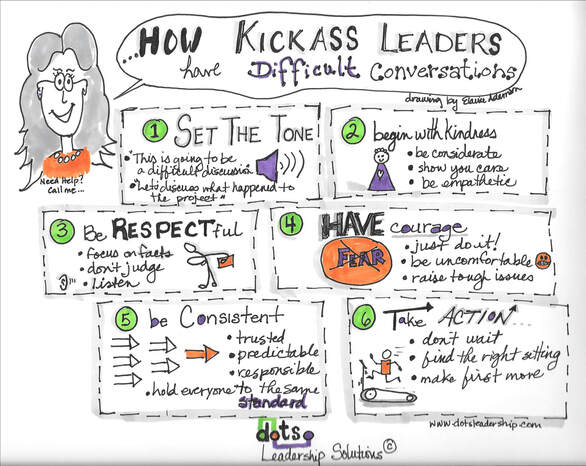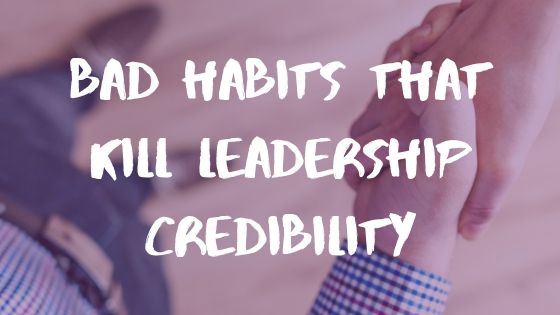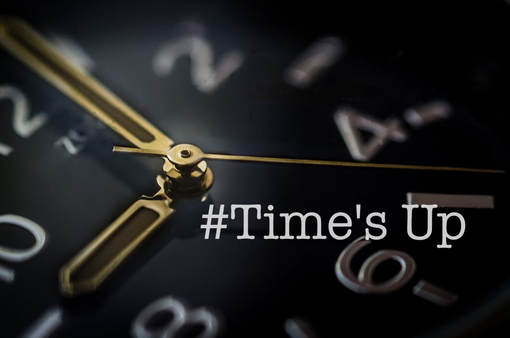How To Have Difficult ConversationsI was delighted when Kim Scott's book Radical Candor came out as I heartily share her views on candid conversations. To me it really is an art, not a science! Just like art, you improved the more often you do it. While there may be steps to take, you only develop comfort for 'uncomfortable discourse' as you practice doing it. I'm not telling you it will be easy. After all, it does go against with what your Momma taught you - 'if you don’t have anything nice to say, don’t say anything at all'. But when you become a leader (just as Kim says) ' it’s your job to speak up--so it's your obligation to be candid'.
0 Comments
Have You Asked Yourself, Am I a Credible Leader?I heard about Tom through leaders in other departments and some of his team.
Tom was a top-level leader; he was sharp, rather humorous, a technically-adept-quick-study, and very good at corporate politics in his highly specialized C-suite role. However what Tom didn’t know, was that most of his team had lost total respect for him as a leader; they didn’t believe half of what he said and few trusted him anymore. As a result, team morale was at an all time low, they spent much of their time cross-checking the many stories he told, second-guessing his every move and gossiping about Tom’s life outside of work. I get it! Difficult people on your team can zap your energy ‘getting on your nerves,’ making it a pain to work with them. Well guess what, I’m here to tell you that pretty much every difficult person you will ever lead, can be a great asset; you may even find them not so difficult after all! This series has been dedicated to helping you figure out how to tap into hidden potential of difficult types and minimize the frustration: - Part one when you’re challenged with a “The Know All” (TKA) - Part two for the blow it up Revolutionary type (TNT) or - Part three the Take No Prisoners (TNP) personality type To wrap up the series, I’m going to help you with one seldom discussed, often misunderstood and a very draining style to work with… the Constant Critic (TCC)! You know this type; they tend to be appear very negative. Just like Eeyore (from Winnie the Pooh) who constantly points out the negative in every move. They don’t cause big drama but they do seem reluctant to get onboard with anything new, usually based on some prior experience. The Constant Critic profile:
Meet Pete – “Mr. Quiet Dissonance” Pete (name changed) has an accounting background and works as a Director, Strategic Planning & Performance for a large Retailer. He's been an executive for 5 years but has been with the company for over 20. The 3 people who report to him quite enjoy working with him. He reports to Marnie (not her real name), VP Business Performance who was recently promoted. Marnie and I have been working together on improving her direct team’s collaboration and she asked for help with Pete, in particular. Pete is commonly referred to as the ‘company historian’ and has lived through a couple of mergers, several name changes as well as take over from a US-based company. Marnie was forewarned that Pete seemed disengaged before she took on the team.
Pete is a great example of the Constant Critic personality type! The good news is Pete responded positively to Marnie as soon as she began implementing strategies we spoke about. Her action plan included:
At this point, her focus is on developing more of a trusted relationship, and that maybe all it takes. Marnie's increased interest in his experience seems to have had a positive impact already; the team has noticed Pete becoming more participatory – no more crossed arms in meetings and some have even commented about him being more sociable. The benefit of having a TCC on your team – great devils advocate, can help you develop persuasive arguments, often sees a different perspective and helps to reflect on pending plans. Often they have learned from past mistakes, can be a historian with very helpful information to draw upon. The key to leading a TCC – remain positive, redirect negativity, stick to facts and data that support positive outcomes. Help them see the impact of their behaviour on others if it becomes a problem. Ask the TCC to reframe their initial reaction toward a more positive response. Caution leading a TCC – do not get pulled into negativity. Limit how much time you give when they become negative. For every difficult type of person, there is a way of changing YOUR perspective about what contribution they bring to your team. It may take a little effort, but drawing upon unique perspectives can be a competitive edge for your team. If you are dealing with a difficult person on your team (or even your boss) and you’d like help to figure out how to communicate better with them, send me an email. There are just as many strategies as there are difficult personality types! Bonus tip: Can you see a bit of yourself in Pete? Have you been 'shutting down' at work, avoiding colleagues or find yourself to be increasingly contrary? You may be a Constant Critic or are heading that way. Time to reflect on how negative you may appear to others:
Photo CC0 @bkotynski Unsplash
Recently, a client (we’ll call her Yvonne) reached out to me for assistance with a ‘know-all’ on her team. We had such great success improving their working relationship and camaraderie on the team that I decided to pass along some tips!
Many business leaders I talk to grapple with rebels or difficult personality types. Difficult people can test your every-last-nerve, yet once you figure out how to curb their behaviour by communicating effectively, you may discover a competitive advantage on your team. Over the next few blogs, I will give you tips on how to handle some of the most draining types of people:
First up is the case of Alan – The Know All (TKA) Alan – The Know All (TKA) Alan was an effervescent, spirited, high-energy team member, who was very smart. He drove people crazy with his need to be right all the time and his non-verbal, superior behaviour in meetings (like eye-rolling, arms crossed, dismissive noises). Trouble was that most days Yvonne found herself doing damage control when people complained Alan was difficult to work with. Alan spent all of their 1:1 meetings complaining about others who were unresponsive or uncooperative, inhibiting him from accomplishing his work and expecting Yvonne to set THEM right. As a result, Yvonne found Alan to be a drain on her time and energy. Due to the culminating behaviour issues, Yvonne seriously questioned whether to keep him on the team despite the great work that Alan did. After Yvonne filled me in on the many issues, it became obvious that Alan did not build rapport with others and his smug behaviour rubbed people the wrong way. So we set out a plan for Yvonne to begin providing Alan with meaningful and actionable feedback, immediately. Alan fell into the TKA-The Know All profile: The Know All profile (exhibits many of these traits)
The key to leading a TKA is to gain trust by showing them you are ‘in their corner’ but challenging them directly on their behaviour so they can see the impact of their current approach.
Caution to leading a TKA – always have your facts and data in order, never threaten or corner. Pick your battles wisely; focus on behaviour that gets in their way of success vs. labeling the person as a problem. The benefit to having a TKA on your team – this type of person has tons of relevant information to draw upon, they are hard workers, creative problem solvers, decisive, action-oriented, have high standards, are adaptive, and are highly productive. The root of Alan’s problems was that he made others feel dumb or undervalued – the more he touted his smarts, the more others did not want to work with him. They resented his approach because he never took time to value their input, he didn't create a relationship, he would talk too fast, not ask questions and express how frustrated he was in a variety of verbal and non-verbal cues. So What Happened? Once Yvonne began providing more directive feedback, Alan started making positive changes in his approach. Fortunately Alan knew Yvonne genuinely cared about his success and even though it was difficult to hear, he soon realized he came on too strong and decided to take her advice. In a few short weeks, Yvonne began to hear from others that Alan was less combative and appeared more team oriented and helpful. Yvonne is now less stressed and has improved her own skills for giving AND receiving feedback. So Difficult People or Competitive Edge? For every difficult type of person, there are ways to connect to capitalize on the strengths they bring while correcting undesirable behaviour. It can take a bit of work on your behalf but building and encouraging diverse perspectives can be a competitive edge for a high performing team! If you are tired of struggling to deal with a difficult person on your team (or even your boss) and you’d like to know how to better communicate with them, send me an email. I have many more strategies that work! Do you know anyone similar to Alan? I'd be interested to hear what strategies work for you to manage their behaviour or if you have another difficult style you struggle with - please leave me a reply below! Sign up for my blog updates (subscribe in the right-hand column) or bookmark the blog page. The next post one will feature: TNT – The Blow It Up Type – think of a ‘Mike Holmes’ like worker who sees many things that need fixing and thrives on change yet balks at routine work. Photo Credit @ergepic from Pexels Creative Commons CC0 Hanging out with my grandson the other day he told me about a neighbourhood bully who makes ‘bad choices’. We had a great conversation about people who make bad choices, particularly bullies. In his vast wisdom of nearly 5 years, my grandson told me ‘Bullies are people too but its not OK when they hurt other people and if they do, then a grown up has to give them a time-out.’ What a thoughtful leadership lesson in this little statement. After all, we use time-outs with children to make them think about their actions, they must apologize and we expect them to do differently so they learn from their experience. So why don’t we tackle bullies in the workplace with the same energy - especially people in a power position over others? What Would You Do? You know the headlines these days are dominated by allegations of sexual harassment; victims are speaking out about their nasty experiences, almost daily - a topic seldom talked about before. Women everywhere have been emboldened to speak up and share their personal stories of sexual harassment and inappropriate behaviour in work situations. With every news story, it triggers another woman's courage to speak out. Rest assured, there will be more to come. Will you know how to manage an allegation at work if someone in your company or organization turns to you for help? Policy and Practices Start with YOU, not HR! Lets face it; dialogue about sexual harassment makes most of us uncomfortable. Anything ugly is difficult to speak about, but open discussion is vital to bring about improvement. It really concerned me when I read the Globe & Mail article that '94 percent of Canadian's leaders believe sexual harassment isn't an issue.' Given harassment has become such a hot topic, every company should recognize that sexual harassment IS a real problem. It is time for leaders, or anyone in a position to help, to stand up, call out and follow through with discipline for inappropriate behaviour. No one should ever feel harassed at work, particularly if it is unwanted and sexualized in nature. It’s just not ok, regardless of how you qualify or explain it away as ‘that is how it is here’. Turning a blind eye to anyone’s harassment claim can make worldwide headlines within a few hours through social media when they don’t get the help they need. So #Time's Up on covering up transgressions of anyone, especially senior level leaders or officials. This is tough stuff to handle but there are steps you can take, immediately, to prevent all forms of harassment from happening at your work. Lets look at how you can create work environments where both men and women feel safe to bring forward concerns and get support rather than feeling they have to go public or leave the company. Think ‘METALS’ - Leadership Steps to Say #Times Up 1. Model. Everyone is watching you whether you know it or not. Don’t speak inappropriately about women (or men); leave any form of sexual innuendo out of the workplace – sexual dialogue does not belong in a work environment. Help your team remain respectful in every interaction, show them how you manage with respect. You are the one your team will imitate, so show people the right way to treat others. 2. Enforce. The basis for change at work begins with having policy as a guidepost. No matter the size of your business, you need policies in place to fall back on to enforce. Ensure your workplace has a clear harassment policy in place with specific actions to take should any disrespectful behaviour occur – regardless of level or position in the company. Check to see that your company has a policy, become familiar and communicate it. If they don’t have a policy, suggest it be implemented ASAP. You can be the catalyst for ensuring a harassment policy is in place, communicated and enforced. 3. Talk. Talk about harassment with your team, long before an issue occurs. When opportunities arise to reinforce, discuss behaviour openly, highlighting what is acceptable and what is not at work. Openly share stories about past personal experiences and state how you would handle it now. Immediately discuss any sign of disrespect you observe or hear about so your team know you will not tolerate it. Make your team aware that they each have a role to play in keeping the workplace safe, people who stay silent are complicit; give them the courage to speak up. You create the environment of open dialogue. 4. Act. In the best work environments ‘respect in the workplace’ is a foundational training piece for all employees so they understand what behaviour is expected of them and what to expect in return. Many people go through training but notice when management doesn’t consistently follow through when something occurs, so they clam up. Be the one who acts swiftly. People want to work for leaders who readily step up and take responsibility for the wellbeing of their people. They will know you care enough about both the ‘bully’ and the bullied to deal with bad behaviour head on. Any form of bullying or inappropriate behaviour should be investigated and acted upon with appropriate discipline, without delay. Action begins with you, not HR. 5. Listen. Treat any form of harassment claim with urgency, seriousness and respect by hearing out those who have the courage to speak up, suspending your own judgement. Ensure a proper investigation is done while taking steps to protect the complainant from any form of retribution. Active listening shows them you care, understand and can be trusted to help. Listening with empathy is a key leadership trait. 6. Speak Up. By respectfully speaking out for those who feel harassed at work, you quickly become a powerhouse leader of tomorrow. Inappropriate behaviour at work is not OK; it is never to be tolerated. By speaking up and supporting others who speak out you will be the leader everyone wants to work for. Take a Stand You make choices everyday for how you treat others, we all do. If someone chooses to be a jerk or worse, an aggressor, then they should face appropriate consequences for their actions, regardless of their position in a company or organization. But it takes strong leadership to follow through with these people and take deliberate action. Take a stand! As a leader you have the ability to choose what your team’s workplace should be like, irrespective of the culture or industry you’re in, or whether you have an HR team. YOU can be the shining example to others in management. YOU count to the people who report to you and how you act during the toughest times will be a key differentiator to their lives. I’m here if you need guidance to manage tough leadership situations. Send me an email if you want support to develop policy or practices to enforce a respectful workplace or you’re struggling with a difficult issue and want a coach to talk it through. Creative Commons Zero (CC0) license
You’ve been there–it could be a pain-in-the-butt colleague, a trouble-making employee, or worse, a devil-boss who makes your workday absolute torture! Regardless of who they are, they likely all have this one thing in common…nasty bullying behaviour. Sadly, if you don’t find ways to manage it, the stress may cause your health to decline, you disengage from work resulting in your performance taking a hit or you have the sudden urge to quit because you simply have no other way out. Dealing with a workplace bully wears us all down. Repeated over time, you may actually believe what they say, sparking self-doubt and eroding your self-esteem. They yearn for this power and as such, once they’ve set their sights on you, they do what they can to take you down. I’ve helped several clients rise above these difficult people. It takes a little bit of work but in the end, they feel a sense of accomplishment once they triumph! It’s important to note that if what you are dealing with is an extreme case of bullying or a possible harassment case, there are Human Rights laws to protect you. Handling those situations requires a formal process. The Ministry of Labour (Ontario) provides guidance to both employers and employees regarding these laws in my province. What I’m talking about today are the scenarios where someone is staying within the bounds of the law, but making it unpleasant for you to work with them. These people know how to get at you but management may not see it, may choose to ignore it, or it just may not be bad enough for you to want to raise a big fuss. The Bully ProfileThese nasty people often share similar characteristics, they:
So what CAN you do to battle this kind of unpleasantness? Lets look at some simple tactics to disarm these bullies and take back your own power:
1. Let them shine It may seem counterintuitive but people who are problematic are typically seeking some kind of attention. Take time to assess this person’s underlying insecurity; ask yourself the following questions to become aware of what is really going on:
With this information in mind, look for a moment to praise them when they do something you can comfortably acknowledge: “Jane had a good point”, “Jane was absolutely right, ‘Thank you Jane for xxx” “Jane I quite liked xxx”. These comments begin to neutralize their need to be nasty because their own esteem rises. However, it’s important that you approach this genuinely. Don’t do it if you don’t really feel it or it will come off as disingenuous and inflame them further. Giving them the limelight is a powerful tool and it works in most situations. 2. Use the power of Aikido If you haven’t heard of it before, Aikido is actually a form of martial arts. Yet, it is non-threatening and doesn’t use force. In fact, what makes Aikido so effective is that it removes aggression from an adversary by yielding to his/her force in a way that they end up only hurting themselves. For instance, imagine stepping out of the way as someone tries to strike you–the attacker would likely fall down, hurting only themselves. Mean people are easily unsettled when you DON'T react the way they are expecting. Because most of these people have very low self-esteem, their actions come from a place of insecurity; they lash out or belittle to make themselves feel better. To use an ‘Aikido-like’ reaction:
3. Find your inner comic Instead of letting these people get under your skin, find a way to make light of their behaviour. I have seen really great leaders deal with some very annoying people simply by making a quick thinking remark. For instance, in the case of an employee continuously interrupting a meeting, the leader might say, “Slow down there speedy, I’m driving this meeting”. If it’s your boss who’s pushing your buttons, this can be a bit trickier but you can still make light of their nasty comments. Laugh out loud and say something like, “Oh, for a moment I thought you were calling me an idiot–that’s a good one”. It may not immediately come to you in the moment, so after an interaction has happened, consider things you could say next time. The AMA has a great article on how to have the last laugh, worth a read! Try to avoid insults as you don’t want to stoop to their level–I’m talking about making light of their comment so you take back control. 4. Call them on the behaviour We naturally try to defend ourselves or strike back when mean people put us down or make a condescending comment. These people have become experts at making others look second-rate so that they can feel superior. That is where they draw strength. If you can’t ignore their comments, respond firmly with a response that exposes the behaviour, “That sounded like a put-down”. It usually holds a mirror up to the individual and catches them off guard. Most of these people won’t want to ‘look bad’ in front of others and a public call-out will make them uncomfortable enough to switch gears. Over time, this tactic can actually help them with their own self-awareness. 5. Nip it in the bud: stage an intervention This approach takes a great deal of courage and I recommend doing this with support. Book a face-to-face meeting with the difficult person and address their behaviour head-on when you are cool-headed. Be sure to have several specific examples at the ready. Make sure your discussion is done in a way to help them understand the affect they have on others. Conduct this meeting in private; clarify what the issue is as factually as possible and set out a plan to fix the problem offering support and guidance. Let them know how these behaviours are making you or your team feel. Use ‘I’ or ‘I feel’ messages. For instance, “I feel embarrassed when I’m called out in a meeting in front of others”, or, “I feel disrespected when I am constantly interrupted in meetings”. ‘I feel’ messages usually resonate better because the other person is not put on the defensive–no one can deny your own feelings. If you have internal HR support, they can assist you in this discussion. If not, then consider bringing in external support to help you plan this discussion and to be present during the meeting. Don’t let nasty people ruin your work experience. Approach them as though they have a problem and don’t let it be your problem anymore. Typically they have developed this behaviour over many years but no one has called them on it. It is possible for them to change, but it takes work on their behalf as well as yours. Most great companies have formal policies to reinforce values for treating people with respect. This is great for employees, but what about you as a leader? Check out our additional posts that deal with bad behaviour like bullying at work: - 6 Strategies for Dealing with Difficult People - Difficult People or Competitive Edge - The Constant Critic - Difficult People orCompetitive Edge - Take No Prisoners If you’re dealing with colleagues or team members who are disrespectful to you, I’m here to help. I can arm you with proven practices to help you manage through the tough stuff. Send me an email or give me a call today, I offer a 30 minute free consultation! How to Deal With Difficult People On Your TeamOne of the most frustrating and time-consuming aspects of every manager’s role is dealing with a difficult person on their team. But getting good at managing the most challenging employee can be well worth the time and effort invested, even if it doesn’t seem it at the time. Not only will you demonstrate top-notch leadership skills to ‘the powers that be’, but you’ll also be role modelling for those you are developing to be a leader – which looks great on you! There are all kinds of difficult people to manage or to work with: the know-it-all’s, passive-aggressive’s, quiet sulker’s, loud mouths, pity partier’s etc. And while you can develop specific strategies for managing each type, I have found there are a few general approaches for dealing with ANY difficult person that are often successful: 1. Understand Your Own Type I know what you’re thinking…’Hey, I’m not the one who is difficult, so why start with me?’ Well, that is because when you understand yourself, you can better strategize how to flex your style to effectively communicate with others. It also helps you recognize why some people drive you to the brink and press your buttons more than others. There are many assessment tools that can be used to develop a greater understanding of your own personality type and how you affect others. DISC, Kolbe and Myers Briggs are quite common and a good place to start; it doesn’t matter which tool you use as long as you do the homework on self-discovery. 2. Understand Each Of Your Team Member’s Type Unsurprisingly, I also recommend understanding the personality type of each of your team – not just the difficult one! Teams are like living organisms; they have reliance and dependency on one other. People get along much better when they learn to appreciate the nuances and differences of each other. Personality assessments provide a non-threatening, consistent language that facilitates the breaking down of communication barriers. 3. Be CANDID! This is not for the faint of heart. Being clear and candid with a difficult person is not easy for most people, yet it is the single most important first step in managing the situation. Regardless of the different types of ‘difficult people’, when you can articulate the issue head on, you’ll make better progress. Help them to understand how their behaviour is impacting the office, the team or any key stakeholders. Good ol’ Dr. Phil says, "You can't change what you don't acknowledge", and that holds true here too. You have to call out what the problem is, particularly when it is causing trouble with others. The way to do this is by clarifying the effect the person’s behaviour is having on others without judgement and blame. A great reference for how to frame these conversations is a book called Crucial Confrontations. Just as the title implies, confronting is crucial! Regardless of how awkward the situation, when you deal with it with compassion and the right intentions, you can work with the person to find solutions. 4. Look For An Underlying Issue I’m not saying you should give them an excuse for their ‘difficult-ness’, but you may find that something may be at the root of their behaviour issues and knowing this will give you a clue for how to manage it. I once worked with a man who, when heard on the phone with his wife, was clearly in a dictatorial relationship – he was a doormat at home, but a tyrant at the office! Once we realized that he had a need to feel in control because he had zero control outside of work, we were able to adapt how we dealt with issues to give him some measure of power within his work. Very quickly, he stopped battling everyone else. Simply put, if you can spot the underlying issue, you can adapt your response. It takes a little thoughtfulness, but it absolutely works. 5. Tap Into Empathy Sometimes you have to walk in someone else’s shoes to understand where they are coming from. Try to put yourself in their situation to understand their point of view before jumping to conclusions. Did you know CCL research shows that, “Managers who show more empathy toward direct reports are viewed as better performers in their job by their bosses.” In today’s social media rich world we are terribly quick to label a difficult person and criticize before taking time to understand who they are and how they view life. In the workplace, it is a big win when you can find the bridge into their way of thinking – you can then help by making a connection and break down the issues. 6. Accept 100% Responsibility For Your Response I often say, no one can make you FEEL anything – how you choose to respond to any tough situation is all up to you. The fact that someone is driving you crazy is a direct reflection of how you are responding to somebody else’s ways. This is completely within your control. This is a tremendously liberating concept when you realize you have the ability to control your response. Brian Tracy - Free Your Mind: How You Are Responsible offers a great snapshot for just how to accomplish this! When it gets really tough dealing with a difficult person and you are about ready to give up or you’ve been trying to follow HR guidance and still not getting at the heart of the matter, give Dots Leadership Solutions a call – we have a kit bag of approaches that have worked very effectively. We also have some great assessment tools and can be available to plan for or facilitate discussions if you need an objective third party! Image from Pixabay CC0
|
Most Popular Posts:
AuthorElaine Adamson is a leadership consultant with Dots Leadership Solutions Inc. A natural dot connector. Passionate about coaching team effectiveness and leadership development she shares over 25+ years of real-life tips and tricks that really work! 
Elaine believes you can discover and leverage strengths to forge a strong team dynamic despite business challenges or organizational change.
She posts some great articles on Linked In too! Topics of Interest
All
Archives By Date
November 2022
|
Specialties |
Company |
|









 RSS Feed
RSS Feed